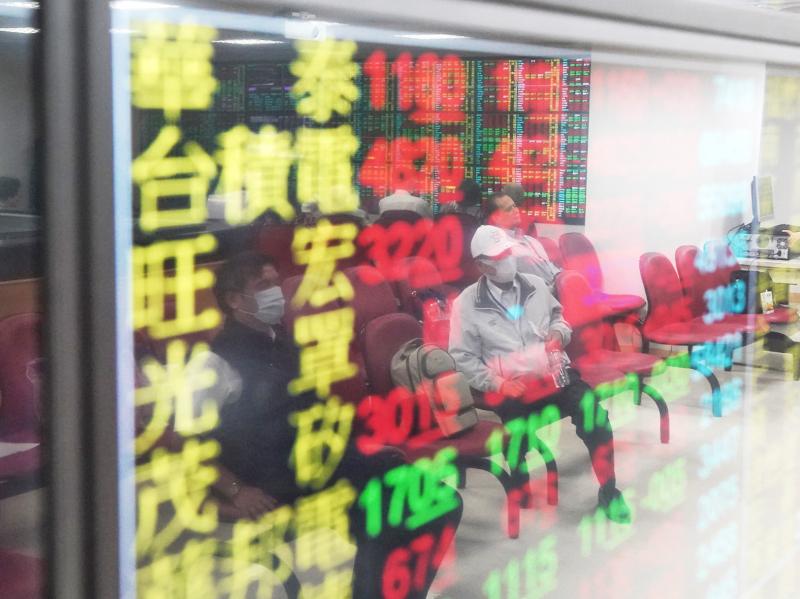The TAIEX yesterday rose 2.1 percent to close at 13,551.83, a record high, despite Taiwan not being included in a regional trade deal signed by 15 Asia-Pacific nations on Sunday.
It was the first time the benchmark index surpassed 13,500 points, Taiwan Stock Exchange data showed.
Turnover was NT$234.691 billion (US$8.15 billion), slightly up from last week’s average of NT$225 billion, while foreign institutional investors bought a net NT$22.87 billion of shares, the data showed.

Photo: CNA
Other Asian markets also advanced after the 15 nations signed the world’s largest regional free-trade agreement, the Regional Comprehensive Economic Partnership (RCEP).
Local shares rose, as they are sensitive to US markets, which rallied on Friday last week, Hua Nan Securities Investment Management Co (華南投顧) chairman David Chu (儲祥生) told the Taipei Times by telephone.
“Taiwan will actually be hurt by the signing of the Regional Comprehensive Economic Partnership on Sunday, as we are not included in the trade agreement, whereas major countries including China, Japan and South Korea are. However, that the TAIEX did not fall indicated that investors did not mind,” Chu said.
A reduction in trade barriers between the 15 RCEP members would not be implemented immediately and it therefore does not pose a short-term threat to Taiwan’s economy, he said.
The growth of the nation’s economy, especially the strength of the local technology sector, also helped relieve some of the anxiety, he added.
As the local stock market is sensitive to Wall Street, the TAIEX’s rise reflected the latest gains in New York, where the Dow Jones Industrial Average rose 1.4 percent on Friday last week, Chu said.
“I was not surprised at all to see a bull market... To put it simply, there is too much money in the system due to easing monetary and fiscal policies worldwide. The question is when the winning streak will end,” he said.
Almost all of the subindices rose, except for the food, textile and rubber sectors, while the electronics, semiconductor and financial sectors reported the largest increases, the data showed.
Taiwan Semiconductor Manufacturing Co (TSMC, 台積電), the most heavily weighted stock in the TAIEX, rose 4.76 percent to close at a new high of NT$484 and a record capitalization of NT$12.55 trillion.
“Thanks to TSMC, the TAIEX steamed ahead today,” Mega International Investment Services Corp (兆豐國際投顧) analyst Alex Huang (黃國偉) said. “I suspect buying largely came from foreign institutional investors, as they simply boosted the spot market to profit in futures.”
November futures contracts are scheduled to be settled tomorrow, so it was no surprise that foreign institutional investors, who are holding a large number of positive futures contracts, scrambled to buy in the spot market, Huang said.
“Further rises are possible until Wednesday, the futures settlement date, but after that I expect the TAIEX to fall into consolidation mode for some time,” he said.
Additional reporting by CNA

TECH BOOST: New TSMC wafer fabs in Arizona are to dramatically improve US advanced chip production, a report by market research firm TrendForce said With Taiwan Semiconductor Manufacturing Co (TSMC, 台積電) pouring large funds into Arizona, the US is expected to see an improvement in its status to become the second-largest maker of advanced semiconductors in 2027, Taipei-based market researcher TrendForce Corp (集邦科技) said in a report last week. TrendForce estimates the US would account for a 21 percent share in the global advanced integrated circuit (IC) production market by 2027, sharply up from the current 9 percent, as TSMC is investing US$65 billion to build three wafer fabs in Arizona, the report said. TrendForce defined the advanced chipmaking processes as the 7-nanometer process or more

China’s Huawei Technologies Co (華為) plans to start mass-producing its most advanced artificial intelligence (AI) chip in the first quarter of next year, even as it struggles to make enough chips due to US restrictions, two people familiar with the matter said. The telecoms conglomerate has sent samples of the Ascend 910C — its newest chip, meant to rival those made by US chipmaker Nvidia Corp — to some technology firms and started taking orders, the sources told Reuters. The 910C is being made by top Chinese contract chipmaker Semiconductor Manufacturing International Corp (SMIC, 中芯) on its N+2 process, but a lack

Who would not want a social media audience that grows without new content? During the three years she paused production of her short do-it-yourself (DIY) farmer’s lifestyle videos, Chinese vlogger Li Ziqi (李子柒), 34, has seen her YouTube subscribers increase to 20.2 million from about 14 million. While YouTube is banned in China, her fan base there — although not the size of YouTube’s MrBeast, who has 330 million subscribers — is close to 100 million across the country’s social media platforms Douyin (抖音), Sina Weibo (新浪微博) and Xiaohongshu (小紅書). When Li finally released new videos last week — ending what has

NVIDIA PLATFORM: Hon Hai’s Mexican facility is to begin production early next year and a Taiwan site is to enter production next month, Nvidia wrote on its blog Hon Hai Precision Industry Co (鴻海精密), the world’s biggest electronics manufacturer, yesterday said it is expanding production capacity of artificial intelligence (AI) servers based on Nvidia Corp’s Blackwell chips in Taiwan, the US and Mexico to cope with rising demand. Hon Hai’s new AI-enabled factories are to use Nvidia’s Omnivores platform to create 3D digital twins to plan and simulate automated production lines at a factory in Hsinchu, the company said in a statement. Nvidia’s Omnivores platform is for developing industrial AI simulation applications and helps bring facilities online faster. Hon Hai’s Mexican facility is to begin production early next year and the